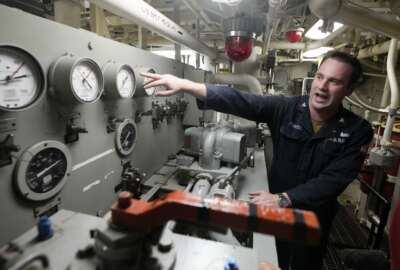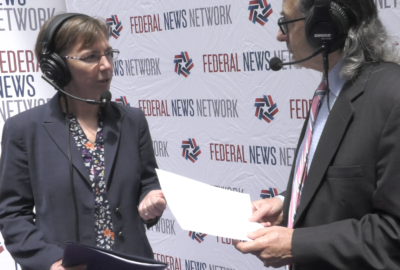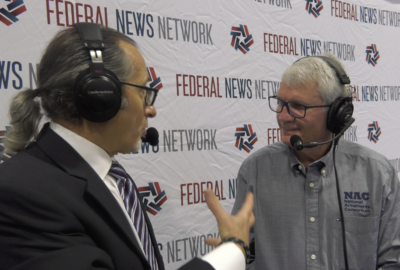The Navy seeks the next generation of energetics for more potent weapons
For the military, any advantage in weapons has a lot to do with energetics, the materials that explode and power projectiles. Recently the Navy awarded other...
Best listening experience is on Chrome, Firefox or Safari. Subscribe to Federal Drive’s daily audio interviews on Apple Podcasts or PodcastOne.
For the military, any advantage in weapons has a lot to do with energetics, the materials that explode and power projectiles. Recently the Navy awarded other transaction authority money to the National Armaments Consortium for the Naval Energetic Systems and Technology program. For more, ironically at last week’s big Army symposium, Federal Drive with Tom Temin caught up with consortium executive director Charlie Zisette.
Interview transcript:
Charlie Zisette: The consortium now is about 950 members. And as we sit here on the floor of AUSA, I can assure you that most of the members are present here, as they’re all doing development and prototyping for both the Army, the Navy and the Air Force.
Tom Temin: Yeah, so armaments consortium are people that make armaments?
Charlie Zisette: Absolutely.
Tom Temin: And do you primarily try to organize around OTAs?
Charlie Zisette: Exactly. In fact, there are three enterprises, as I call them OTA enterprises. And the first one is the Department of Defense Ordnance Technology Consortium, which is really focusing on our armaments across all the services. And we also have where we joined with the Vertical Lift Consortium and the National Armaments Consortium to form the Aviation and Missile Technology Consortium. And we just were awarded by the United States Navy, a third OTA called the Naval Energetics and Systems Technology Consortium.
Tom Temin: Yeah, and I want to get into that, but just before we do get into the details there, when you get an award, does it go to the consortium and then you adjudicate among members for that development or how does that work?
Charlie Zisette: Almost like that Tom, it’s close. So what the military does is provide the requirements to us, we push those out to all 950 members with a distribution list of over 4,000 researchers, and then we receive their proposals, the government adjudicates those, and then we make the awards directly to those members through the consortium.
Tom Temin: In other words, the military awarding organization kind of trusts you as a broker for where that money will go.
Charlie Zisette: Absolutely. They direct us to go to the company that they believe has the best technology. Today, we have over 500 research projects that are over $2 billion across many of our companies.
Tom Temin: Alright, let’s talk about the newest one, the NEST idea, naval energetic systems and technology. Well, I thought everything having to do with military systems that are aimed at something are energetic. Let’s define energetic first of all.
Charlie Zisette: Let’s define that. It is very much the grassroots of all lethal weapon systems and also non lethal because we use propellants, explosives, pyrotechnics, all the ingredients that you have to manufacture in order to develop these formulations to be able to put them into the systems, whether they’re projectiles, warheads, bombs, rocket motors, all of those things are based on energetic materials. And it is a critical time for us in our nation. And I think the Navy is really leading out and understanding that we need a renaissance to bring back the technology both in manufacturing and development of new molecules, and new propellants, new explosives, etc. so that we can continue to be dominant on the battlefield.
Tom Temin: I guess a lot of people don’t realize unless they’re in the business that explosives is a constantly changing field. And it’s nothing like, the fireworks of the 1920s are nothing like the chemical formulations we have now.
Charlie Zisette: Yeah, you’re absolutely right. And when we want lighter systems that can go further or go faster, we have to adjust the energetics. How do we get more powerful propellants? How do we get more lethal explosives to be able to put in smaller packages and yet continue to deliver the same lethality on target?
Tom Temin: So the Navy is looking generally for energetics that have these qualities that are lighter, more powerful, manufacturable and also domestically source-able. Is that a good way to put it?
Charlie Zisette: You hit it right on. And that last one, which I hadn’t mentioned, is very critical, we’ve got to make sure that we can stay within our supply chain within the United States and not beholden to other nations for our materials.
Tom Temin: And to what degree does the need for things to go hypersonically fit into this NEST idea?
Charlie Zisette: In a couple of areas. One is you got to get the system up and running. And so often we’ll launch with rocket assistance. We also have to do things like ramjet technologies, and being able to do new types of combustion research so that we can really get those hypersonic velocities. And that is a lot of the modeling and simulation that goes on behind the scenes. It’s not just a bunch of people sitting in a laboratory with beakers. There’s a lot of technology that we leverage to get us to where we need to be.
Tom Temin: It sounds like some old technologies or old techniques being revitalized, when you say ramjet, the first jets were ram jets in the 40s – right?
Charlie Zisette: Right, you’re exactly right. Maybe it’s not quite at these velocities.
Tom Temin: Right. And the Navy gave up on a railgun project that was some, I guess electromagnetic, is this, in some sense, they’re looking for something instead of electromagnetic, which was too expensive or too unreliable, or way too much, took too much power, whatever they they felt they couldn’t deploy it.
Charlie Zisette: That’s correct. And so we’ll continue to look for how do we get maybe it’s better sea launched ballistic missiles or surface launched tactical missiles. How can we do other types of energetics for defense, right? When we’re maybe threatened by a swarm of uADS, all those different both offense and defense systems, if you will, are reliant on our energetics, and we’ve got to adjust and modernize as we go.
Tom Temin: Now this is the Navy looking for this particular program, naval energetics, could this have applicability across the other armed services?
Charlie Zisette: Oh, my gosh, while all this is going on, Tom, what we are in the midst of right now is what we call the national energetics planning phase. And due to Congress asking for the Department of Defense to reassess our entire industrial base for energetics across all the service, so this really is a national issue, it is not just a Navy issue. And I think that’s where the national armaments consortium comes into play, because we are an association of all the energetic materials developers and producers. And so now we can work in a cooperative way with the Department of Defense to really address this entire both public and private partnership.
Tom Temin: We’re speaking with Charlie Zisette, the executive director of the National Armaments Consortium. And is there evidence that say the other countries that are also rivals that have engineering and scientific talent, Russia, China, for example, I guess, even India — are they also chasing energetics? Do we know what’s going on?
Charlie Zisette: We do. Suffice to say that they are chasing, and they’re running pretty fast. And I’ll leave it at that.
Tom Temin: All right. And so what’s the timeline here, and what happens when someone has a discovery of this work well, on a range or in a lab, what happens?
Charlie Zisette: Well that’s right. There is a very disciplined process, because we are dealing with energetic materials.
Tom Temin: Don’t try this in your kitchen.
Charlie Zisette: Absolutely, you don’t want to try this in your kitchen. And I have, I think what we call an accelerated development pipeline, by using these OTAs ,so that we can get through this development lifecycle as quickly as our safety and environmental etc. allows us, but we’ve got to move quick, and so I think we’re demonstrating that now.
Tom Temin: And what happens in between the proof of concept, say, under the OTA and at the point at which the military branches in this case, the Navy would want to start acquiring these in quantity in production?
Charlie Zisette: Well, that’s one of the beautiful things of the other transaction agreement, or the OTAs does allow us to move right from prototype straight into production. And that was defined in the statute by Congress because they saw the demand signal that we’ve got to be agile, and we’ve got to be rapid. And so that’s one of the beautiful things, we can actually use this contracting vehicle, if you will, with the Department of Defense to move quickly, right, from prototyping to production.
Tom Temin: But there’s also the issue of the Defense Department and the military services being pretty slow to adopt new technology in quantity, something may work well in a test range, but till they’re ready to deploy it on all the ships, or on all the aircraft and so forth — I mean, it took the Army 10 years to replace a pistol.
Charlie Zisette: Well, you’re absolutely right, Tom. And there are days that sometimes we all feel like we’re pushing a 500 pound block of jello. But the truth is, we’re all pulling together. And that’s how I kind of look at it, I kind of think of it as more of a tug of war. When we’re all aligned together, we pull together, we move quickly. And I think that’s what we’re seeing is a little bit better alignment in energetics, and we need more of that.
Tom Temin: Because the military acquiring these new energetics would have to test the energetic, not just in the lab, but also in their entire logistics chain system, which is pretty complex for storage, loading, however, they get it into the back end of a thing that fires — and then also safety and handling and mounting it on a wing or in a magazine or whatever the case might be. Sounds easy to say, but it’s it’s pretty complex.
Charlie Zisette: It’s very complex, as it needs to be. And we’ve got to be judicious, but we also got to be rapid. And I think that it speaks to the importance of alignment, but your absolutely really Tom, this is not something that you just simply can cookie cut, and roll.
Tom Temin: And if you had a chance to see anything blow up that looks promising?
Charlie Zisette: Well, we’ve actually had an amazing event just this last week on the Army’s long range precision fires program where through our OTA program, one of our member companies demonstrated the ability to shoot at 155 XM, 11113 over 70 kilometers
Tom Temin: That’s a missile?
Charlie Zisette: It’s 155 millimeter howitzer shell, which is intended to be a precision guided weapon, and we doubled the range. We’ve done something just now that we thought we wouldn’t even be able to do until 2023. But because of this accelerated approach and prototyping, we demonstrated over 70 kilometers, which is just amazing.
Tom Temin: So now the challenge is to make them for $25 a piece.
Charlie Zisette: I’ll keep you posted on that one.
Copyright © 2025 Federal News Network. All rights reserved. This website is not intended for users located within the European Economic Area.
Tom Temin is host of the Federal Drive and has been providing insight on federal technology and management issues for more than 30 years.
Follow @tteminWFED






